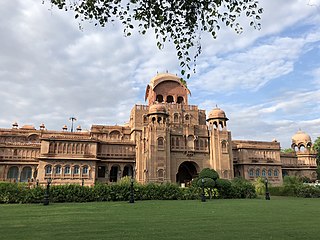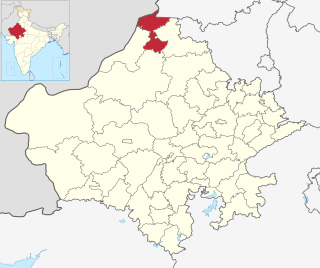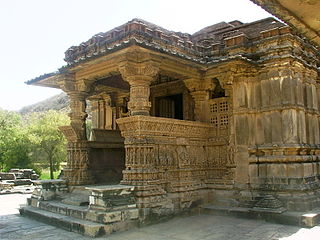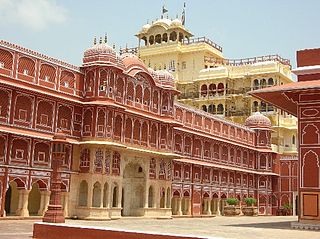The year 1902 in architecture involved some significant events.

Bikaner is a city in the northwest of the state of Rajasthan, India. It is located 330 kilometres (205 mi) northwest of the state capital, Jaipur. Bikaner city is the administrative headquarters of Bikaner District and Bikaner division.
Rao Bika Rathore, was the founder of the Kingdom of Bikaner in present-day Rajasthan. He was a scion of the Rathore clan of Rajputs. He was a son of Rao Jodha, founder of the kingdom of Marwar. Rao Bika got Godara Jats to accept their subordination in Bikaner region.

Mehrangarh Fort covers an area of 1,200 acres in Jodhpur, Rajasthan, India. The complex is located on a hilltop around 122 metres above the surrounding plain, and was constructed c. 1459 by Rajput ruler Rao Jodha, though most of the existing structure is from the 17th century. Inside its boundaries there are several palaces known for their intricate carvings and expansive courtyards, as well as a museum housing various relics. A winding road leads to and from the city below. The imprints of the impact of cannonballs fired by attacking armies of Jaipur can still be seen on the second gate. At the north-east of the fort is the chhatri of Kirat Singh Soda, a soldier who fell on the spot defending Mehrangarh.

Sri Ganganagar is the northernmost city of the Indian state of Rajasthan, near the international border of India and Pakistan. It is the administrative headquarters of Sri Ganganagar district. It is named after Maharaja Shri Ganga Singh Bahadur, Maharaja of Bikaner. The city is also known as the "Food Basket of Rajasthan".

Sri Ganganagar district is the northernmost district of Rajasthan state in western India.

General Maharaja Sir Ganga Singh,, was the ruling Maharaja of the princely state of Bikaner from 1888 to 1943. As a member of the Imperial War Cabinet, he was present in the Palace of Versailles during The Signing of Peace in the Hall of Mirrors.
Rajyashree Kumari is a former competition shooter from India. The Arjuna Award in shooting was conferred on her in 1968, when she was 16 years old.She is the daughter of Dr. Karni Singh, Maharaja of Bikaner, daughter of Maharaja Maharani Sushila,

Junagarh Fort is a fort in the city of Bikaner, Rajasthan, India. Raja Dhaj, Ror Kumar, ruled over the principality of Junagarh in the fifth century BC. The fort was originally called Chintamani and was renamed Junagarh or "Old Fort" in the early 20th century when the ruling family moved to Lalgarh Palace outside the fort limits. It is one of the few major forts in Rajasthan which is not built on a hilltop. The modern city of Bikaner has developed around the fort.

The region of Bikaner, stretching across northern Rajasthan State in India, was earlier known as Jangladesh. It included the present-day districts of Bikaner, Churu, Ganganagar, and Hanumangarh. It is bounded on the south by Marwar and Jaisalmer regions, on the east by Ajmer-Merwara region.

The architecture of the Indian state of Rajasthan has usually been a regional variant of the style of Indian architecture prevailing in north India at the time. Rajasthan is especially notable for the forts and palaces of the many Rajput rulers, which are popular tourist attractions.

The Rambagh Palace in Jaipur, Rajasthan is the former residence of the Maharaja of Jaipur located 5 miles (8.0 km) outside the walls of the city of Jaipur on Bhawani Singh road.

Lake Palace is a former summer palace of the royal dynasty of Mewar, it is now turned into a hotel. The Lake Palace is located on the island of Jag Niwas in Lake Pichola, Udaipur, India, and its natural foundation spans 4 acres (16,000 m2). Popularly described as the Venice of the East, Udaipur hosts the pristine Lake Palace, curated out of white marble.

Shiv Niwas Palace is a former residence of the Maharana of Udaipur, Rajasthan, located on the banks of Lake Pichola.

Sir Samuel Swinton Jacob,, known as Sir Swinton Jacob, was a British Army officer and colonial engineer, architect and writer, best known for the numerous Indian public buildings he designed in the Indo-Saracenic style.

Rajasthan is one of the most popular tourist destinations in India, for both domestic and international tourists. Rajasthan attracts tourists for its historical forts, palaces, art and culture with its slogan "Padharo Mhare Desh " Jaipur, is also known as Pink City, is a very popular tourist destination, being the capital of Rajasthan and a part of the Golden Triangle. The Walled City of Jaipur is a UNESCO World Heritage Site and is only the second Indian city to be recognized, after Ahmedabad.

Bikaner State was a princely state in the Rajputana from 1465 to 1947. The founder of the state, Rao Bika, was the eldest son of Rao Jodha, ruler of Jodhpur. Rao Bika chose to build his own kingdom instead of inheriting his father's. Bika defeated the Jat clans of Jangladesh along with his uncle Rao Kandhal and his adviser Vikramji Rajpurohit and founded his own kingdom. Its capital was the city of Bikaner in the northern area of present-day Rajasthan State in India. Karni Mata has been designated as the kuldevi of the Royal family of Bikaner.

Rajput architecture is an architectural style notable for the forts and palaces of the many Rajput rulers, which are popular tourist attractions, many of the Rajput forts are UNESCO World Heritage Site.


















